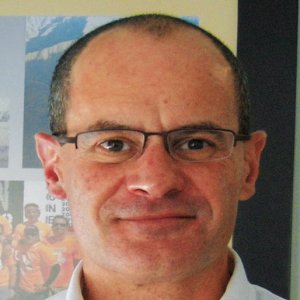Digitalizing the Future

STORY INLINE POST
Q: What process does a clinic undergo once it hires your digitalization services?
A: The success of these kinds of solutions relies on how well they are designed according to each customer’s specifications. There are many variables to take into account that will define the optimum design: the existing medicalimaging equipment, its operating status, a hospital’s infrastructure, human resources, current volume of studies per type and its growth projection. We begin by sending an engineer to do a survey of the situation and assess what growth may look like for the following one to two years in terms of demand, new equipment, specialties and new health units. This will determine the type of hardware, its capacity, infrastructure adjustments, software and tools that will better suit today’s needs and those in the medium term. Part of our added-value is the ability of our engineers to design a custom-made solution ready to scale up to the client’s future plans. Another differentiation factor we offer is service. We train all a customer’s staff that will operate or interact with the solution. We continue to provide training over the term of the contract to compensate for employee rotation and natural knowledge loss and we focus on preventive maintenance to anticipate system failures, new needs and to avoid operating downtimes. This is also empowered by our expertise, which is our biggest strength.
Q: What can digitalization mean for a company in terms of savings?
A: When technicians take an image with analog film, they check the image’s clarity with a radiologist and decide if the image should be retaken. Twenty-five percent of analog studies have to be repeated, which means that patients have to be irradiated twice, 25 percent of films are wasted and the x-ray tube is used 25 percent more. Appointment deferrals for image studies are another big problem of analog technology because in some cases these deferrals can be of two months or more; digitalization can reduce that. This allows other savings, such as with fees related to incapacitations, which can be lowered as a result of having a patient diagnosed more quickly. A timely diagnosis can save lives. Doctors can see more details on digital images, zoom in, analoguely track changes, change contrast, brightness and carry out a faster and more precise diagnosis. If needed, a doctor can ask for a second opinion from a colleague who can access the image remotely, avoiding the need to transfer patients between hospitals.
Q: What is the next step to expand healthcare digitalization in Mexico and what role does Eseotres want to play in this process?
A: Image digitalization opportunities are infinite and we have seen this on our mobile devices. Soon, our medical history will be on the cloud. What will change is the selection criteria of patients because we will prefer institutions that can upload our clinical information to a shared platform. For these solutions to be as effective as possible, these platforms should be cross-institutional, private or public, and cross-manufacturers. Eseotres wants to be the platform where these changes happen. We want to develop a cloud without institutional, brand or manufacturer barriers. The vast majority of imaging studies done by public health institutions is archived in boxes. Through digitalization, the studies’ archives can be easily retrieved and shared and become a source of Big Data to develop useful information for the creation of health policies, efficient resource allocation and productivity measurement. Public health institutions are doing what they can but it is important that we as business do our part to facilitate the adoption of these solutions. It is unreal to think that one company can satisfy the entire public demand alone and the same goes for other public health institutions; this is why the technical standardization of these solutions is a priority. We need to make sure that any solution that we install anywhere in Mexico can connect to any other solution in the market.
Q: You are a former Walt Disney Home Entertainment executive. How do you apply that expertise to healthcare?
A: The shift from home entertainment media to medical imaging was drastic. However, sometimes there are similarities within seemingly very different industries. When I started working at Disney, movies were sold in VHS and DVD before digital arrived. Video on demand, digital download, streaming and other forms of digital distribution generated changes within the company and at an industry level; new and different partners, business models, different pricing, marketing, operations as well as a different meaning of product ownership to the retail and to the end customer. Something similar happens in the medical imaging industry. We went from selling X-ray films to offering digitalimaging services, from selling a consumable to selling an intangible digital image. Therefore, this similarity with the industry I come from helps me understand how important this change is for the industry, how deeply it affects the different stakeholders and what can we do to be prepared to embrace and take advantage of that change.
Q: How has the adoption of digitalization in the health sector evolved in Mexico?
A: IMSS carries out between 19 and 20 million image studies every year. We are still its providers of analog films and they still buy around 1.5 million square meters. We believe that only between 25-30 percent of its imaging studies are digitalized, so there still is an important opportunity to broach. However, it has to standardize their process. There are around four or five companies offering solutions similar to ours. The most digitalized countries are looking for, or have already adopted, a digitalization solution where the images can be shared among different institutions. IMSS is the biggest health institution in Latin America and it will be a great advantage if at some point it could have the information of all its patients in the same platform available for all its clinics, and moreover, such a platform should also be shared across health institutions. The High Specialty Medical Units (UMAES) are already digitalized; they have their own budget and government. We have applied our solutions in 19 hospitals in San Luis Potosi and 29 in State of Mexico, where we want to finish the digitalization of the units that still use analog film processing. The results in these clinics have been great, they have radically increased their productivity as a consequence of the technology itself and the reduction of service downtimes, and there is an impact on the diagnosis quality as well.
Q: What are the challenges of digitalization in Mexico?
A: The first challenge is to achieve a cultural acceptance of change, to break the barrier of resistance to install solutions whose end product is digital and not tangible. Our clients have been working 15 to 20 years in the same way so it is not easy to make them embrace change. Working with public institutions presents other challenges. Budgets need to be reassigned, to adjust to service contracts. Tenders often do not have a proper budget to contract the needed digitalization services. Some budget items, such as those assigned to the maintenance of old filmdeveloping processors, should be assigned to the digital imaging services. In addition, the process of tenders is complicated as there is a lack of standardization and technical specifications often do not match the real customer’s needs, they also require the presentation of past contracts with public institutions to demonstrate the company’s expertise; this is a bit contradictory when we consider the few contracts for this kind of service that the public institutions have signed.
This is why we received with great anticipation the IMSS Innovation Olympics, an event that IMSS launched in March 2017 for the first time. We see this competition as a key aspect that was missing for IMSS to properly adopt innovation; a space where the public and private sectors can transparently team up to develop innovative solutions that are tailor-made to fit the reality and needs of the institution.






















